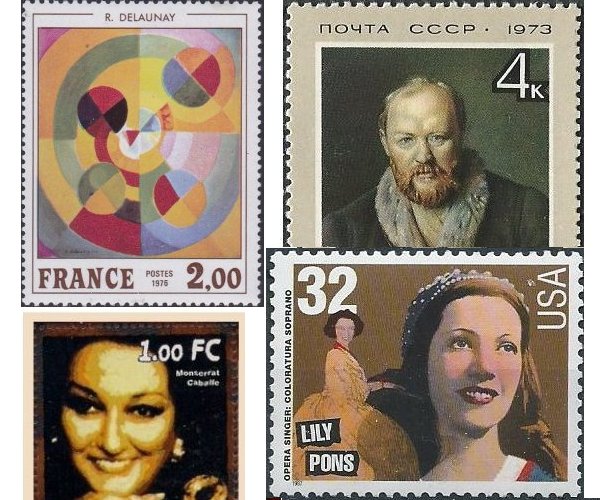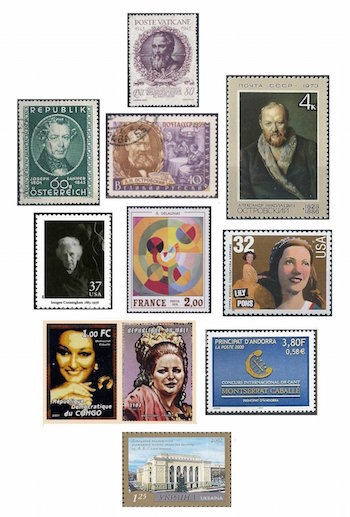The Arts on the Stamps of the World — April 12
An Arts Fuse regular feature: the arts on stamps of the world.

By Doug Briscoe
I suppose today’s star performers would be Russian playwright Alexander Ostrovsky, the great operatic sopranos Lily Pons and Montserrat Caballé, and French artist Robert Delaunay, but again we’ll tackle our subjects chronologically.
Born on this day 533 years ago was the Florentine architect Antonio da Sangallo the Younger (12 April 1484 – 3 August 1546). He was apprenticed to Donato Bramante and went on to work mostly in Rome and the Papal States. His first important commission was for the church of Santa Maria di Loreto in 1507. On the death of Bramante, Sangallo was one of those chosen by Pope Leo X to continue the work on St. Peter’s Basilica. Sangallo was also an ingenious engineer—but assigned to drain the Rieti Valley, he contracted malaria and died of it before completing the project.
A composer of Viennese dance music, Joseph Lanner (12 April 1801 – 14 April 1843) was a contemporary and friend (and rival) of Johann Strauss the Elder. He wrote about 200 waltzes, polkas, quadrilles, etc., before expiring of typhus two days after his 42nd birthday. Last week I mentioned that this stamp was one of the many designed by the Austrian artist Wilhelm Dachauer.
Alexander Nikolayevich Ostrovsky (12 April [O.S. 31 March] 1823 – 14 June [O.S. 2 June] 1886) wrote 47 plays, constituting a core block of pre-Chekhovian Russian dramatic literature. His mother died when he was eight, but in a reversal of the usual sad tale, Ostrovsky’s step-mother was a strongly positive influence, a person of refinement committed to education. While studying law he became interested in poetry and the theater. He met with early success but trouble with the censors, who continued to make a nuisance of themselves into the 1860s. No fewer than three Ostrovsky plays inspired music by the young Tchaikovsky: the early overture “The Storm”, the incidental music to The Snow Maiden, and the opera The Voyevoda (but not the symphonic ballad of the same name, which derives not from Ostrovsky’s play but rather from Pushkin). The Snow Maiden is the same story used for one of Rimsky-Korsakov’s better known operas; Dream on the Volga was brought to the operatic stage by Arensky; and The Storm served as the basis of Leoš Janáček’s opera Kát’a Kabanová. The more recent of the two Ostrovsky stamps shows a portrait of him by Vasily Perov (1834 – 1882).

American photographer Imogen Cunningham (April 12, 1883 – June 23, 1976) was born in Portland, Oregon and grew up in Seattle. When she was eighteen she bought a mail order camera, but didn’t become seriously interested in photography until college, where she earned a degree in chemistry. After further study in Dresden she began making portraits, turning soon to botanical images. She also became known for her nudes and industrial landscapes.
Robert Delaunay (12 April 1885 – 25 October 1941), with his wife Sonia and Czech artist František Kupka, cofounded Orphism, a movement with its roots in Cubism, with elements of Fauvism and Divisionism and a leaning toward the abstract. Time now for me to admit that I’m in over my head. I gather the idea is that colors themselves form the quasi-Cubist building blocks of the work of art. Quite in keeping with that concept, much of Delaunay’s pre-Orphist work is Pointillist in the manner of Seurat. There, sounds as if I know what I’m talking about. Meanwhile, just looking at the stamp has made it a bit clearer.
The great Lily Pons (April 12, 1898 – February 13, 1976) was born Alice Joséphine Pons near Cannes. At 15, she won First Prize in piano at the Paris Conservatory and went on to play for French soldiers during World War I. She was 27 before she began to study voice! Her debut was as Lakmé at Mulhouse in 1928, and within two years she was singing at the Met, having taken over many of the roles of the recently retired Amelita Galli-Curci. Pons, now known as “Lily”, would remain with the Met for thirty years, until 1960. She appeared in a few films, including That Girl from Paris (1936) with Henry Fonda, and became a naturalized US citizen in 1940. She and her husband Andre Kostelanetz performed with the USO on several fronts during the Second World War. There is a village in Maryland called Lilypons in her honor.
Another great singer is the Spanish soprano Montserrat Caballé (born 12 April 1933). She was born María de Montserrat Bibiana Concepción Caballé i Folch in Barcelona. She made her debut as Mimì in 1956 in Basel, where she was making her home at the time. Back in Barcelona in 1962, she made her Liceu debut (we just saw stamps for that opera house on the 4th inst.) singing the title role in Richard Strauss’s Arabella. She came to international fame when she filled in for an ailing Marilyn Horne at Carnegie Hall in 1965. Later that year she first performed with the Metropolitan Opera in Gounod’s Faust (Sherrill Milnes made his Met debut on that same occasion). Two decades of international performing and recording followed. In 1987 she had a hit with a duet (“Barcelona”) with rock star Freddy Mercury. She has been married to the tenor Bernabé Martí since 1964. Caballé is celebrated on two sheets of opera stamps from the African nations of Congo (Kinshasa) and Mali. The Andorran stamp commemorates Ms. Caballé’s International Singing Competition, founded in 1997.
The Donetsk Opera and Ballet Theater, aka Opera Donbass, was originally established in 1932. A new building was begun in 1936 and opened just two months before the outbreak of war between Germany and the USSR. The first performance given there was of Glinka’s Ivan Susanin on April 12, 1941. Although the city (known throughout this period and until 1961 as Stalino) was virtually destroyed during the war, I was unable to learn whether the building itself suffered any damage. The theater was later named for the tenor Anatoliy Solovyanenko (1932 – 1999), a native of Donetsk.
A graduate of the University of Massachusetts with a B.A. in English, Doug Briscoe worked in Boston classical music radio, at WCRB, WGBH, and WBUR, for about 25 years, beginning in 1977. He has the curious distinction of having succeeded Robert J. Lurtsema twice, first as host of WGBH’s weekday morning classical music program in 1993, then as host of the weekend program when Robert J.’s health failed in 2000. Doug also wrote liner notes for several of the late Gunther Schuller’s GM Recordings releases as well as program notes for the Boston Classical Orchestra. For the past few years he’s been posting a Facebook “blog” of classical music on stamps of the world, which has now been expanded to encompass all the arts for The Arts Fuse.

